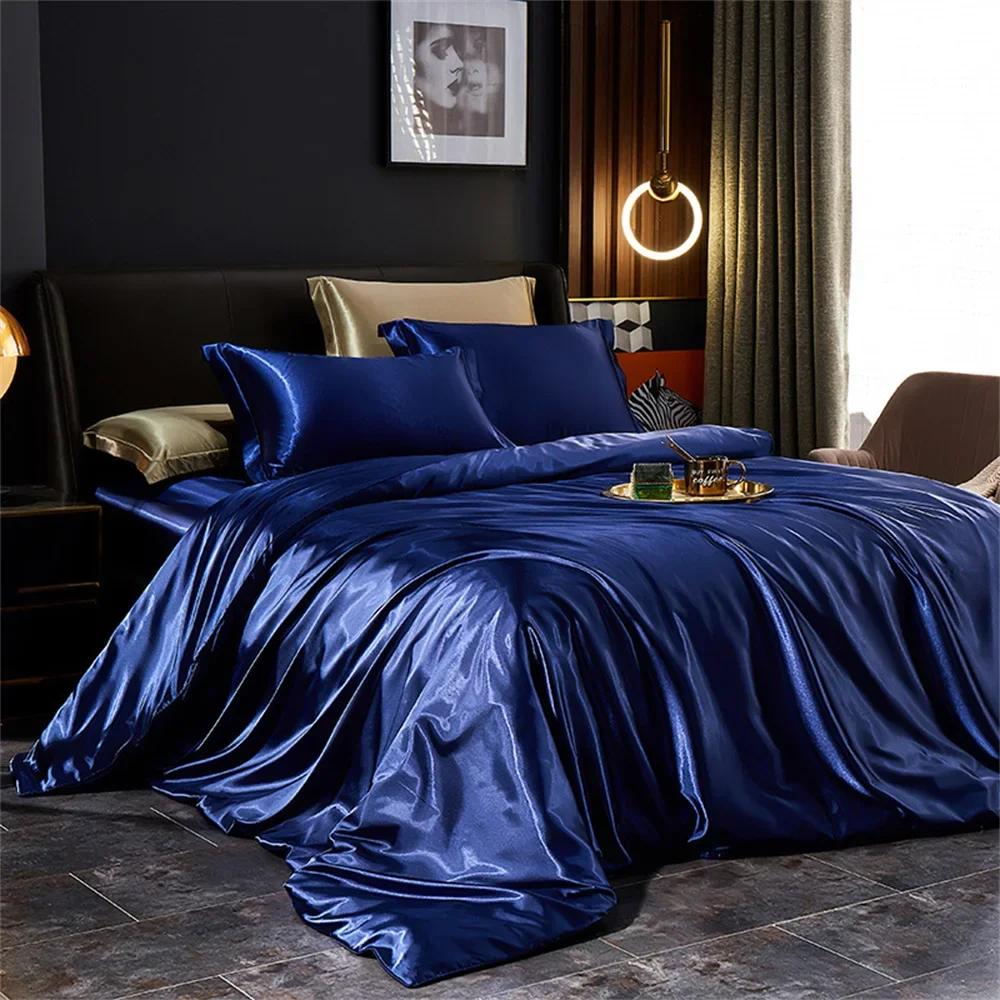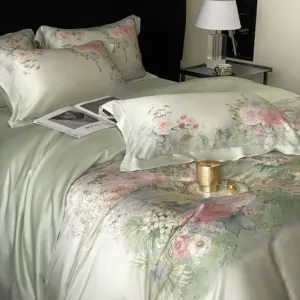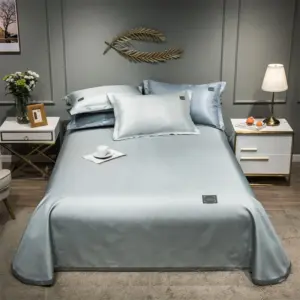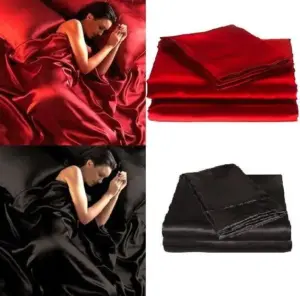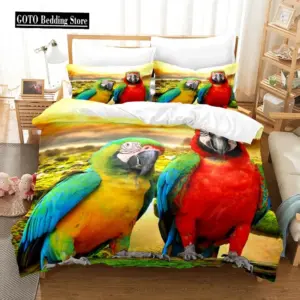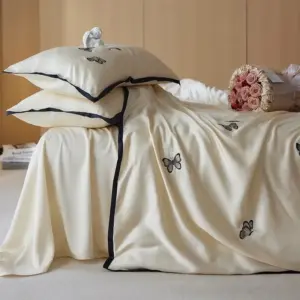What Is Vegan Silk?
Vegan silk refers to a range of innovative textiles designed to mimic the luxurious qualities of traditional silk without using any animal products. Unlike conventional silk, which requires silkworms and their cocoons, vegan silk alternatives are entirely plant-based, protein-based, or bioengineered materials that offer similar qualities like softness, drape, and luster.
These alternatives fall into several categories: plant-based cellulose fibers (like lyocell and modal), agricultural waste-derived materials (such as pineapple and orange fiber), protein-based options (like soy silk), and cutting-edge bioengineered fibers. Each type offers its own unique properties while maintaining the core silk-like characteristics that consumers desire.
As sustainable fashion continues to evolve, these amazing benefits of Mulberry silk sheets are being matched by vegan alternatives that don’t compromise on luxury or performance. The growing market for vegan silk demonstrates a significant shift in consumer preferences toward more ethical and environmentally conscious textile choices.
When comparing traditional and vegan silks, most alternatives successfully replicate the signature shine and smooth hand-feel, though each material has its own distinct profile of strength, breathability, and durability characteristics.
Why Choose Vegan Silk Over Traditional Silk?
Traditional silk production follows a process that hasn’t changed much for thousands of years. It involves cultivating silkworms specifically to harvest their cocoons, which requires boiling or steaming the cocoons with the silkworms still inside. This process kills the developing moths before they can emerge naturally, raising significant ethical concerns for those who avoid animal products.
Vegan silk alternatives offer compelling benefits:
Ethical advantages:
– Completely cruelty-free production that doesn’t harm any living creatures
– No animal breeding or exploitation involved
– Aligns with vegan lifestyle choices and animal welfare concerns
Environmental benefits:
– Many vegan silks require significantly less water than traditional silk production
– Reduced land usage compared to mulberry cultivation for silkworms
– Several options utilize agricultural waste that would otherwise be discarded
– Many varieties are biodegradable at the end of their lifecycle
Performance qualities:
– Often more durable and easier to care for than traditional silk
– Many options are machine-washable (unlike conventional silk)
– Comparable or better moisture-wicking and temperature regulation
The environmental impact differences are striking. While conventional silk requires intensive mulberry cultivation and silkworm rearing, materials like orange fiber silk repurpose waste products from the juice industry. Similarly, options like Tencel use closed-loop systems that recycle over 99% of solvents and minimize water consumption.
These considerations make vegan silk increasingly appealing to environmentally conscious consumers looking for sustainable alternatives without sacrificing the pros and cons of silk and vegan silk that make these fabrics so desirable.
Core Principles of Vegan Silk Production
The creation of vegan silk alternatives follows three fundamental approaches, each with distinct production methods but sharing common goals of mimicking silk’s desirable properties.
Plant-Based Cellulose Extraction
This approach utilizes the cellulose fibers found in plants, which are then chemically or mechanically processed to create silk-like materials. The process typically involves:
– Harvesting and preparing raw plant material
– Extracting cellulose through chemical or mechanical means
– Dissolving cellulose in solvents to create a viscous solution
– Extruding the solution through spinnerets to form continuous filaments
– Solidifying the filaments and removing solvents
– Drawing and treating the fibers to enhance silk-like properties
Protein-Based Fiber Synthesis
These methods focus on plant proteins rather than cellulose to more closely mimic the protein structure of natural silk:
– Extracting proteins from plant sources (typically agricultural by-products)
– Purifying and concentrating the protein content
– Processing the proteins into a spinnable solution
– Creating fibers through wet or dry spinning techniques
– Treating the fibers to enhance performance and appearance
Bioengineered Approaches
The most technologically advanced methods use microorganisms to produce silk proteins:
– Engineering microorganisms (usually yeast) with silk protein genes
– Fermenting these organisms to produce silk proteins
– Harvesting and purifying the proteins
– Processing the proteins into fibers using specialized techniques
– Finishing the fibers to achieve desired properties
Each of these vegan silk sustainable production process approaches offers different advantages in terms of scalability, environmental impact, and performance. The best method often depends on the specific application and the particular silk qualities needed for the end product.
How Plant-Based Cellulose Fibers Are Made
Plant-based cellulose fibers represent the most widely available category of vegan silk alternatives, with several established manufacturing processes that create luxuriously smooth textiles.
Lyocell/Tencel Production
Lyocell, often marketed under the brand name Tencel, is produced using a remarkably sustainable process:
Raw Material Preparation: Sustainably harvested wood (typically eucalyptus, beech, or spruce) is chipped and pulped to extract cellulose.
Dissolution: The cellulose pulp is dissolved in a non-toxic organic solvent called NMMO (N-Methylmorpholine N-oxide) to create a clear, viscous solution.
Closed-Loop Processing: The solution is pushed through spinnerets (tiny holes) into a water bath where the fibers solidify. The solvent is recovered at an impressive 99.5% rate and reused continuously.
Fiber Treatment: The resulting fibers are washed, dried, and sometimes treated with enzymes to create the characteristic silk-like drape and softness.
The entire system creates minimal waste and requires significantly less water than traditional viscose processing, making it one of the most environmentally friendly vegan silk options.
Modal Manufacturing
Modal uses a modified viscose process but starts with beechwood pulp:
Cellulose Extraction: Beechwood is processed into pure cellulose.
Chemical Processing: The cellulose undergoes alkalization with sodium hydroxide and then reaction with carbon disulfide.
Fiber Formation: The resulting solution is extruded into an acid bath to create continuous filaments.
Specialized Finishing: Modal undergoes unique finishing treatments that enhance its silky feel, luster, and strength when wet.
The result is an exceptionally soft fabric with better moisture-wicking properties than conventional viscose.
Bamboo Textile Processing
Bamboo can be processed into textile fibers using two distinct methods:
Bamboo Viscose (most common):
– Bamboo stalks are crushed and treated with strong chemicals
– Cellulose is extracted and dissolved into a viscous solution
– Solution is forced through spinnerets and solidified in an acid bath
– Resulting fibers are spun into yarnMechanical Bamboo (less common):
– Bamboo is crushed mechanically without chemicals
– Natural gums are broken down with natural enzymes
– Fibers are combed out and spun into yarn
– End product resembles linen more than silk
The plant-based silk guide shows that while bamboo grows quickly with minimal resources, the chemical viscose process raises environmental concerns. More sustainable options include bamboo processed using the lyocell method, which employs closed-loop chemical systems.
Our bamboo silk sheets offer the luxurious feel of silk with the sustainable benefits of bamboo fibers, providing an excellent alternative for those seeking eco-friendly bedding options.
Agricultural Waste to Luxury Fabric: Creating Fruit-Based Silk
One of the most innovative developments in vegan silk production involves transforming agricultural waste materials into luxurious textiles. This approach not only creates silk-like fabrics but also addresses waste management challenges in the food industry.
Pineapple Fiber (Piñatex) Production
Pineapple leaf fibers, once considered waste after fruit harvesting, now form the basis of silk-like materials through this process:
Waste Collection: After pineapple harvest, leaves that would normally be left to rot are collected from farmers.
Decortication: The leaves undergo decortication—a process that separates fibers from other plant material either manually or using specialized machinery.
Fiber Extraction: The extracted long fibers are washed, dried, and purified to remove impurities.
Non-Woven Mesh Creation: The fibers are formed into a non-woven mesh through mechanical processes rather than traditional spinning.
Finishing: The material undergoes finishing treatments to enhance its silk-like properties, softness, and durability.
What makes this process remarkable is that it requires no additional land, water, fertilizers, or pesticides beyond what’s already used for food production.
Orange Fiber Manufacturing
Italian company Orange Fiber has pioneered a method to create silk-like fabric from citrus juice by-products:
By-Product Collection: Citrus waste (primarily orange peels) from juice production is collected.
Cellulose Extraction: A patented process extracts cellulose from the peels.
Processing: The cellulose undergoes chemical treatment to create a spinnable solution.
Yarn Creation: The solution is spun into fibers using techniques similar to lyocell production.
Fabric Development: The resulting yarn is woven or knitted into a fabric with remarkable silk-like qualities.
The final material has a soft, lightweight feel comparable to silk and can be blended with other fibers or used pure for luxury applications.
Banana Silk Creation
Banana silk utilizes the stems of banana plants, which are typically discarded after fruit harvesting:
Stem Collection: After banana harvesting, the stems are collected rather than being discarded.
Fiber Extraction: The stems are cut and the fibers are stripped either manually or mechanically.
Processing: The extracted fibers are boiled in a solution to remove natural gums and resins.
Spinning: The cleaned fibers are dried and spun into yarn either by hand or using spinning machines.
Weaving: The yarn is woven into fabric that has a natural sheen reminiscent of silk.
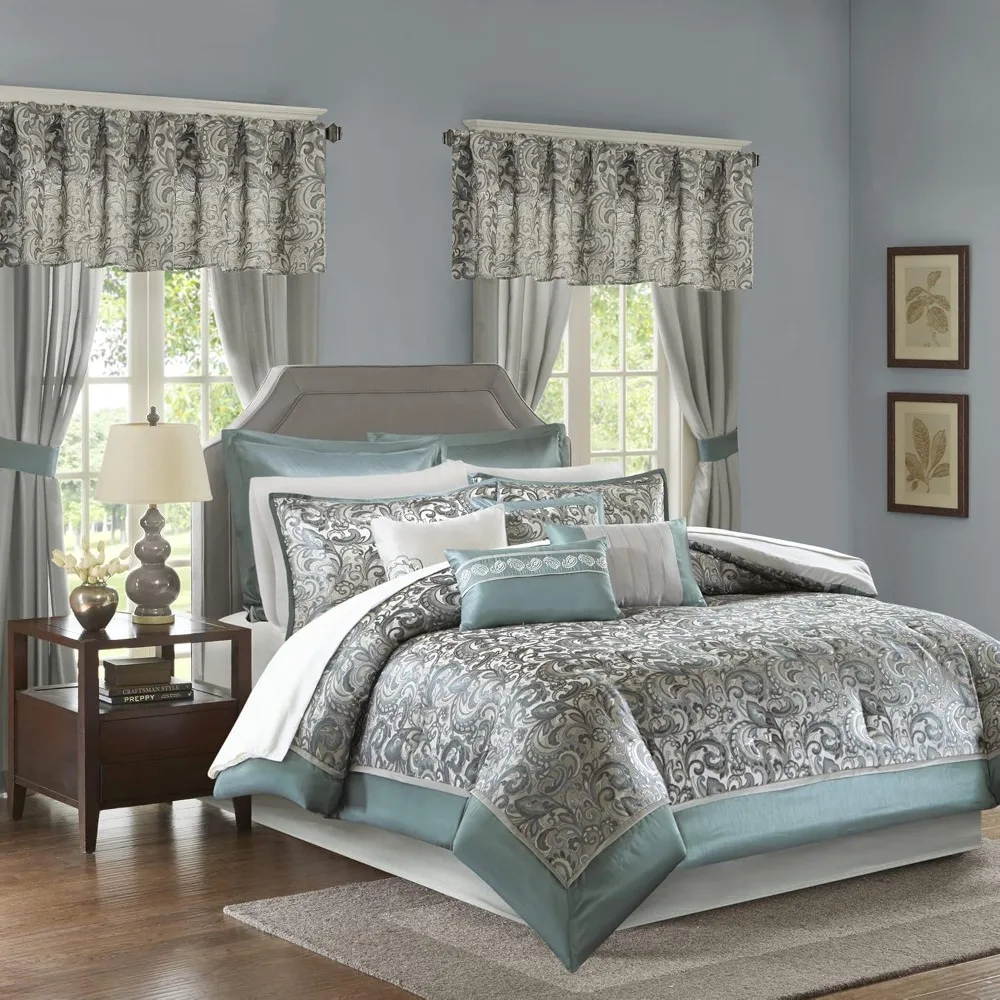
From a sustainability perspective, these methods excel by transforming what would be agricultural waste into valuable textiles, creating additional income for farmers while reducing disposal issues.
Lotus Silk: The Rare Handcrafted Vegan Fiber
Among vegan silk alternatives, lotus silk stands out as perhaps the most labor-intensive and rare fiber in the world. Originating in Myanmar (Burma) and Cambodia, this extraordinary textile has been produced for centuries using techniques passed down through generations.
The production process is entirely manual and requires exceptional skill:
Stem Harvesting: Lotus stems are harvested from lakes and ponds where the plants grow naturally. The best fibers come from stems harvested in the morning when the plants are most resilient.
Time-Sensitive Processing: The stems must be processed within 24 hours of harvesting before they dry out and the fibers become impossible to extract.
Manual Fiber Extraction: Skilled artisans cut the stems and gently pull them apart, revealing thin, sticky fibers inside. With delicate hand movements, they twist and pull these strands away from the stem.
Thread Formation: Multiple extracted fibers are hand-rolled together on a flat surface to create a continuous thread. This requires incredible precision as the fibers are extremely delicate.
Natural Finishing: The threads are washed with rice water to remove natural starches and then air-dried. They receive minimal chemical treatment, preserving their organic qualities.
The resulting fabric is incredibly lightweight, breathable, and has a natural ivory color with a subtle sheen. It’s also remarkably cool to the touch, making it perfect for warm climates.
The resource requirements for lotus silk are staggering: approximately 32,000 lotus stems are needed to produce enough fabric for a single scarf, requiring over 40 hours of skilled handwork. This explains why authentic lotus silk is one of the most expensive textile fibers in the world, often commanding higher prices than traditional silk.
Despite its cost, lotus silk represents the pinnacle of eco-friendly silk production, as it uses no chemicals, minimal water, and creates sustainable income for traditional artisan communities.
Protein-Based Vegan Silk Production
Protein-based vegan silks represent an innovative approach that more closely mimics the chemical structure of traditional silk, which is primarily composed of proteins. These alternatives focus on plant proteins rather than cellulose to create fibers with silk-like properties.
Soy Silk Manufacturing
Soy silk begins as a by-product of tofu and soybean oil production, making it an excellent example of upcycling:
By-Product Collection: Soy protein residue (okara) that remains after soymilk and tofu production is collected rather than discarded.
Protein Isolation: The protein is extracted and purified from the residue through a series of chemical processes.
Solution Preparation: The isolated proteins are dissolved in a solution to create a viscous liquid suitable for fiber formation.
Wet Spinning: This solution is extruded through spinnerets into a coagulating bath that causes the protein strands to solidify into continuous filaments.
Drawing and Finishing: The resulting fibers are stretched to improve strength and treated with finishing agents to enhance their silk-like qualities.
The finished soy silk has a protein content of approximately 30%, giving it a warm feel similar to silk and cashmere. It offers excellent moisture absorption and release, natural antibacterial properties, and good drape.
Other Plant Protein Sources
Research into alternative plant protein sources for textile applications continues to expand:
Pea Protein Fibers: Utilizing the proteins from yellow peas to create biodegradable fibers with silk-like properties.
Milk Protein (Casein): While technically not plant-based, some vegan silk alternatives use casein proteins derived from plant-based milks rather than animal milk.
Algae Proteins: Emerging research explores using protein from various algae species to create sustainable textile fibers.
These protein-based fibers offer advantages over cellulose-based alternatives because their chemical structure more closely resembles that of natural silk proteins (fibroin and sericin). This structural similarity allows them to better mimic silk’s unique combination of strength and flexibility.
Our eucalyptus silk sheets provide another excellent plant-based alternative that delivers exceptional softness and comfort while maintaining an environmentally responsible production process.
Bioengineered Silk: From Laboratories to Fashion
Bioengineered silk represents the cutting edge of vegan silk technology, using advanced biotechnology to create proteins identical or similar to those found in natural silk without involving silkworms or spiders.
Spider Silk Protein Technology
Natural spider silk is one of nature’s most remarkable materials—five times stronger than steel by weight yet more flexible than nylon. Creating this material without spiders involves:
Gene Identification: Scientists identify and isolate the genes responsible for silk protein production in spiders.
Genetic Engineering: These genes are inserted into host organisms (typically yeast, bacteria, or even plants) that can produce the same proteins.
Fermentation: The engineered organisms are grown in controlled fermentation tanks where they produce the silk proteins.
Protein Harvesting: The proteins are extracted and purified from the fermentation broth.
Fiber Formation: The purified proteins are processed into fibers using various techniques that mimic how spiders naturally extrude silk.
Bolt Threads Microsilk Process
Bolt Threads, a pioneering biotech company, has developed Microsilk using a distinctive approach:
Custom Yeast Engineering: They’ve created genetically modified yeast containing spider silk genes.
Sugar Fermentation: The yeast ferments sugar (a renewable resource) to produce silk proteins.
Protein Isolation: The silk proteins are separated from the yeast cells and purified.
Fiber Spinning: The proteins are dissolved in a specialized liquid solution and then extruded through spinnerets.
Water Bath Solidification: The extruded protein strands solidify as they pass through water, forming continuous fibers.
Processing: These fibers are then processed into yarns and fabrics.
Bolt Threads has partnered with fashion brands like Stella McCartney to bring these materials to market, demonstrating the commercial viability of bioengineered silk alternatives.
Other Biotech Companies and Approaches
Several companies are developing alternative approaches to bioengineered silk:
Spiber (Japan): Uses precision-engineered microorganisms to produce various silk proteins with customizable properties.
AMSilk (Germany): Creates BioSteel fiber using engineered bacteria to produce spider silk proteins for textiles and medical applications.
Kraig Biocraft Laboratories: Develops transgenic silkworms that produce spider silk proteins, creating a hybrid approach.

What makes these bioengineered approaches particularly promising is their scalability. Unlike natural spider silk, which cannot be harvested at commercial scale (spiders are territorial and cannibalistic), these laboratory methods can potentially produce unlimited quantities with consistent quality.
Innovative Sustainable Practices in Vegan Silk Production
The development of vegan silk alternatives has sparked numerous innovations in sustainable manufacturing that go beyond simply replacing animal products. These practices are reshaping textile production to address environmental challenges across the entire supply chain.
Closed-Loop Manufacturing
Many vegan silk producers have embraced closed-loop systems that minimize waste and resource consumption:
Water Recycling: Advanced filtration systems in Tencel production recover up to 99% of water used, dramatically reducing consumption compared to conventional textile processing.
Solvent Recovery: In lyocell manufacturing, organic solvents are continuously captured, purified, and reused rather than being discharged as waste.
Minimal Waste Generation: Orange Fiber and similar agricultural waste-based silks transform what would be discarded materials into valuable textiles, creating circular economic models.
Energy Efficiency Innovations
Energy consumption represents a significant environmental impact in textile production. Vegan silk manufacturers are implementing various solutions:
Renewable Energy Integration: Several producers have transitioned manufacturing facilities to solar, wind, or other renewable energy sources.
Process Optimization: Technical improvements in fiber extrusion and drying processes have reduced energy requirements by up to 30% in some facilities.
Co-Location Strategies: Some agricultural waste-based silk producers locate processing facilities near source farms to minimize transportation energy and emissions.
Chemical Impact Reduction
Traditional textile processing often involves harsh chemicals. Vegan silk production frequently employs safer alternatives:
Biodegradable Processing Agents: Enzymes and other biodegradable compounds replace persistent chemicals in fiber preparation and finishing.
Non-Toxic Dyes: Plant-based and low-impact dyes reduce water pollution and eliminate heavy metals often found in conventional textile colorants.
Reduced Chemical Diversity: Simplified production processes use fewer types of chemicals, making water treatment more effective.
These sustainable manufacturing approaches make our vegan silk bedding an environmentally responsible choice without compromising on luxury or comfort. The industry continues to evolve, with new innovations regularly emerging to further reduce environmental footprints.
How Vegan Silk Compares to Traditional Silk in Performance
When considering vegan silk alternatives, many consumers wonder how these materials compare to traditional silk in practical terms. Each vegan option offers a different profile of properties, with some outperforming conventional silk in specific areas.
Tactile Properties
The feel and drape of fabric are essential considerations for silk alternatives:
Lyocell/Tencel: Exceptionally soft with excellent drape, often described as feeling “cooler” and smoother than traditional silk.
Modal: Very soft with a silky luster, though slightly less crisp than traditional silk.
Bamboo Viscose: Incredibly soft with a heavy drape that feels luxurious but differs from silk’s distinctive lightness.
Fruit-Based Fibers: Vary considerably, with orange fiber silk having a remarkably similar hand-feel to traditional silk, while pineapple-based materials typically feel slightly more textured.
Lotus Silk: Incomparably light and breathable, with a unique texture that many consider superior to traditional silk for warm-weather wear.
Durability Factors
Longevity and wear resistance matter significantly for investment pieces:
Traditional Silk: Strong when dry but weakens when wet; degrades with exposure to perspiration and sunlight.
Cellulose-Based Vegan Silks: Generally more durable than traditional silk, maintaining strength when wet and resisting degradation from body oils.
Protein-Based Alternatives: Similar strength profile to traditional silk but often with better resistance to UV damage.
Bioengineered Options: Can be engineered for specific strength characteristics, with some spider silk alternatives offering extraordinary tensile strength.
Care Requirements
Ease of maintenance represents a significant advantage for many vegan silk options:
Traditional Silk: Typically requires dry cleaning or delicate hand washing with specific pH-neutral cleaners.
Lyocell/Modal/Bamboo: Often machine washable on gentle cycles, making them significantly more convenient.
Fruit-Based Fibers: Care requirements vary, but most are more washable than traditional silk.
Lotus Silk: Requires careful hand washing similar to traditional silk.
Many consumers find that is vegan silk as good as real silk comes down to specific preferences and needs. Those prioritizing easy care and durability often prefer vegan alternatives, while those seeking specific traditional silk properties may find certain alternatives closer to the complete guide to Mulberry silk bed sheets in characteristics.
Eucalyptus Silk Bedding Sets, Eucalyptus Silk Sheets
Price range: $360.24 through $393.60 Select options This product has multiple variants. The options may be chosen on the product page- Price range: $267.82 through $306.55 Select options This product has multiple variants. The options may be chosen on the product page
Bamboo Silk Sheets, Cooling Silk Sheets
Price range: $130.76 through $177.80 Select options This product has multiple variants. The options may be chosen on the product pageBamboo Silk Sheets, Queen Size Silk Fitted Sheet
Price range: $230.24 through $297.88 Select options This product has multiple variants. The options may be chosen on the product page- 100% Bamboo Fiber Parrot Duvet Cover Set – Queen King Twin Size Tropical Bedding for Comfort & StylePrice range: $241.95 through $380.95 Select options This product has multiple variants. The options may be chosen on the product page
Bamboo Silk Bedding Sets, Bamboo Silk Sheets, King Size Silk Pillowcases, Queen Size Silk Pillowcases
Price range: $376.20 through $402.27 Select options This product has multiple variants. The options may be chosen on the product page
Is Vegan Silk Always Environmentally Friendly?
While vegan silk alternatives avoid animal exploitation, their environmental credentials deserve careful examination. Not all vegan options are created equal when it comes to sustainability.
Chemical Processing Concerns
The chemical processes used to transform plant cellulose into silk-like fibers vary significantly in environmental impact:
- Standard viscose (including most bamboo viscose) uses carbon disulfide, which can cause serious environmental and health problems if not properly managed.
- Lyocell/Tencel employs a significantly safer solvent (NMMO) in a closed-loop system that minimizes pollution risks.
- Fruit-based fibers often require less intensive chemical processing, particularly when mechanical extraction methods are used.
Water Usage Considerations
Water footprints differ dramatically between vegan silk types:
- Conventional viscose production can require substantial water volumes for processing and diluting chemicals.
- Closed-loop systems like those used for Tencel reduce water consumption by up to 95% compared to conventional viscose.
- Lotus silk requires minimal additional water beyond what the plants naturally use during growth.
Energy Requirements
Manufacturing energy needs vary based on production methods:
- Bioengineered silks currently have higher energy requirements due to laboratory conditions and specialized processing.
- Agricultural waste-based silks generally have lower energy footprints as they utilize existing waste streams.
- Transportation energy should also be considered—locally produced options may have advantages over imported alternatives.
While most vegan silks offer environmental benefits compared to conventional silk, consumers seeking truly sustainable options should look for third-party certifications like GOTS (Global Organic Textile Standard), OEKO-TEX, or Forest Stewardship Council endorsements that verify environmental claims.
The unveiling benefits of vegan silk bedding demonstrates how the best options combine ethical production with genuine environmental advantages, creating truly sustainable alternatives to traditional silk.
Caring for Your Vegan Silk Products
Proper care dramatically extends the life of vegan silk items while maintaining their luxurious look and feel. Different vegan silk types have specific care requirements, but many offer easier maintenance than traditional silk.
General Care Guidelines
• Always check specific manufacturer instructions, as recommendations may vary by brand and specific material blend.
• Use mild, pH-neutral detergents free from enzymes and bleaches.
• Wash in cool or lukewarm water rather than hot water.
• Avoid fabric softeners, which can coat fibers and reduce breathability.
• Air dry when possible, or use dryer’s lowest heat setting if machine drying is approved.
Material-Specific Instructions
Lyocell/Tencel and Modal:
• Generally machine washable on gentle cycle in mesh laundry bag
• Remove promptly from washer to prevent wrinkles
• Hang to dry or tumble dry on low
• Iron on low heat if needed
Bamboo Viscose:
• Machine wash cold on gentle cycle
• Use mild detergent
• Avoid bleach and fabric softeners
• Air dry or tumble dry on lowest setting
Fruit-Based Fabrics:
• Hand washing recommended for most types
• Lay flat to dry away from direct sunlight
• Iron on low heat setting if necessary
Bioengineered Silks:
• Follow specific brand instructions as properties can vary
• Generally require gentler handling similar to traditional silk
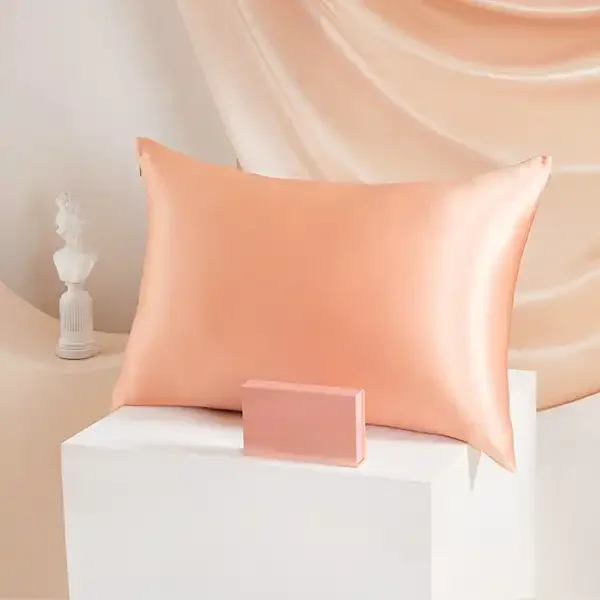
Troubleshooting Common Issues
For wrinkles: Use a steamer rather than iron when possible. If ironing, use low heat and a pressing cloth.
For pilling: Remove pills with a fabric shaver designed for delicate textiles.
For fading: Store away from direct sunlight and wash with color-protecting detergents.
With proper care, high-quality vegan silk alternatives like our eucalyptus silk bedding sets can maintain their beauty and performance for years, offering excellent value alongside their ethical advantages.
The Future of Vegan Silk Innovation
The landscape of vegan silk alternatives continues to evolve rapidly, with exciting developments emerging from both research laboratories and commercial enterprises. These innovations promise to further close any remaining performance gaps between traditional and vegan silk while enhancing sustainability credentials.
Researchers are exploring an expanding range of plant sources beyond the current options. Seaweed and algae show particular promise due to their minimal land and freshwater requirements, potentially offering truly sustainable scaling possibilities without competing with food production.
Bioengineering approaches are making remarkable strides in mimicking specific silk properties. Rather than simply approximating silk’s feel, these technologies can target precise characteristics like specific tensile strength, elasticity, or thermal regulation properties. This tailoring ability may eventually create materials that surpass natural silk in performance for specialized applications.
Manufacturing scale represents a significant challenge for newer vegan silk varieties. While established options like lyocell and modal are widely available, many innovative alternatives remain limited in production capacity. Industry partnerships are addressing this challenge, with major textile manufacturers investing in scaling technologies for promising alternatives.
Consumer affordability continues to improve as production methods mature. While some options like lotus silk will likely remain luxury materials due to their intensive production requirements, others are becoming increasingly competitive with traditional silk on price. As technology advances and economies of scale take effect, this trend toward accessibility is expected to continue.
Leading fashion houses are increasingly incorporating vegan silk alternatives into their collections, signaling broader market acceptance. This mainstream adoption helps drive further innovation and investment in the sector.
For consumers seeking to experience these innovative materials today, options like our bamboo silk bedding sets offer an accessible entry point to enjoy the benefits of vegan silk alternatives with the reassurance of established manufacturing processes.
As research continues and production methods evolve, the future of vegan silk promises even more impressive materials that combine luxury, performance, and sustainability in ways that benefit both consumers and the planet.

